Key Takeaways:
- Northern Gaza Strip: The Israel Defense Forces published details of a division-sized clearing operation it has been conducting for the past two weeks in western Gaza City.
- Southern Gaza Strip: The Israel Defense Forces continued to conduct clearing operations in western Khan Younis.
- Political Negotiations: Unidentified Egyptian officials warned that Egypt would suspend the 1979 Egypt-Israel peace treaty if Israel conducted a ground operation into Rafah.
- West Bank: Israeli forces clashed with Palestinian fighters four times.
- Southern Lebanon and Golan Heights: Iranian-backed militias, including Lebanese Hezbollah, conducted six attacks from southern Lebanon into northern Israel.
- Iraq: The Islamic Resistance in Iraq claimed that the United States violated “the rules of engagement” when it killed senior Kataib Hezbollah member Wissam Mohammed Saber al Saedi.
- Yemen: US Central Command forces conducted preemptive, self-defense strikes targeting Houthi unmanned surface vessels and missiles.
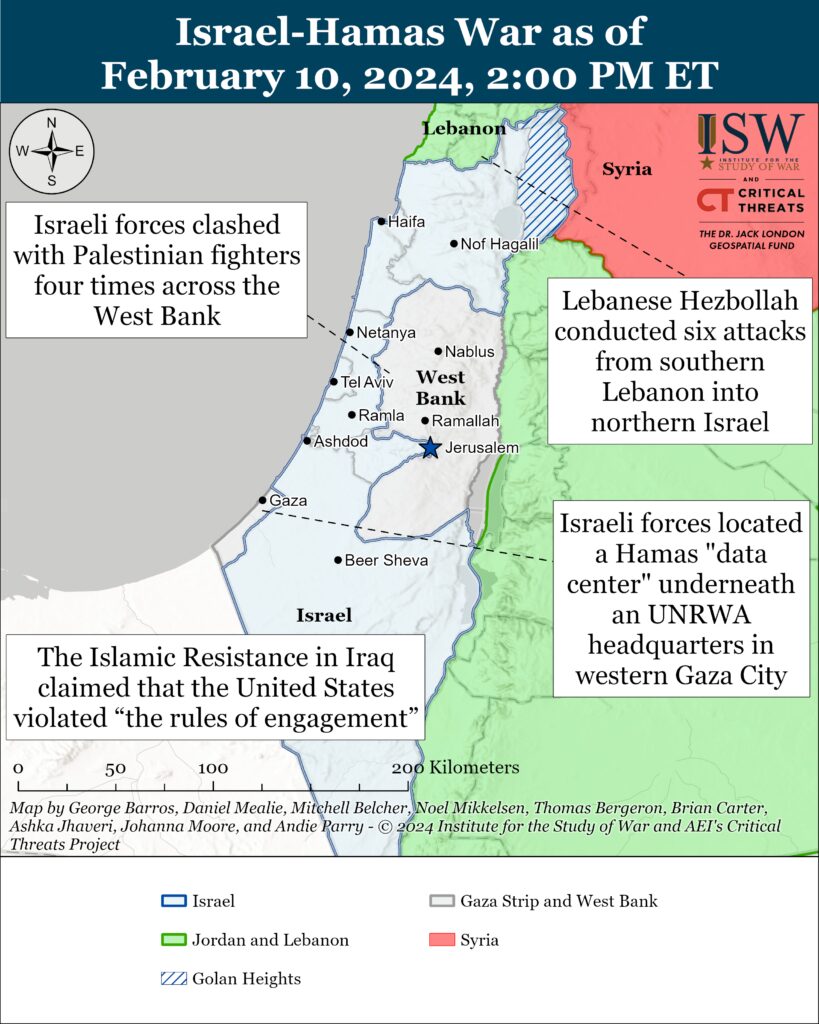
Gaza Strip
Axis of Resistance campaign objectives:
Erode the will of the Israeli political establishment and public to launch and sustain a major ground operation into the Gaza Strip
Degrade IDF material and morale around the Gaza Strip.The Israel Defense Forces (IDF) engaged in “intense” fighting with Palestinian fighters in the northern and central Gaza Strip on February 10.[i] Hamas fighters fired anti-tank rocket-propelled grenades (RPG) targeting Israeli forces southwest of the Zaytoun neighborhood of Gaza City.[ii] Palestinian media reported on February 10 that Israeli artillery targeted areas in eastern Jabalia.[iii] The IDF Nahal Brigade (assigned to the 162nd Division) killed and detained an unspecified number of Palestinian fighters in the central Gaza Strip.[iv] Palestinian Islamic Jihad (PIJ) fighters mortared Israeli forces east of Maghazi in the central Gaza Strip.[v]
The IDF published on February 10 details of a division-sized clearing operation it has been conducting for the past two weeks in western Gaza City.[vi] The IDF 401st Brigade (assigned to the 162nd Division) and Israeli special operations forces (SOF) killed approximately 120 Palestinian fighters and destroyed Hamas infrastructure in al Shati refugee camp and the Tal al Hawa neighborhood of Gaza City. Israeli forces located a Hamas “data center” underneath the headquarters of the UN Relief and Works Agency for Palestinian Refugees in the Near East (UNRWA) in addition to weapons inside the headquarters.[vii] Israeli Prime Minister Benjamin Netanyahu showed US Secretary of State Antony Blinken photos of the tunnel underneath the UNRWA headquarters on February 7.[viii]
The IDF continued to conduct clearing operations in western Khan Younis on February 10. The IDF 89th Commando Brigade (assigned to the 98th Division), 35th Paratroopers Brigade (assigned to the 98th Division), and the 646th Brigade (assigned to the 99th Division) found large quantities of weapons and clashed with Palestinian fighters.[ix] PIJ fighters returned from the areas of fighting in western Khan Younis and reported several attacks targeting Israeli forces.[x] A physician at Nasser Hospital in western Khan Younis reported that Israeli tanks reached the hospital gates on February 10.[xi] Associated Press reported that the IDF said that it is not currently operating inside the hospital and called the surrounding area “an active combat zone.”[xii]
The IDF conducted an airstrike targeting three Hamas members, including two senior military operatives, in Rafah.[xiii] Western media and Palestinian sources reported that Israeli airstrikes in Rafah killed two policemen and three senior officers in the Civil Police on February 10.[xiv] One of those killed was Ahmed al Yaqoubi, who was ”responsible for security for senior Hamas leaders and served as a senior commander in the Rafah district.”[xv] The IDF identified another member as Iman Rantisi, who was Yaqoubi’s deputy, according to Palestinian sources.[xvi] The IDF have targeted Hamas’ police and internal security apparatus to disrupt Hamas’ attempts to rebuild its governing authority.[xvii] The Civil Police and the Hamas-controlled InterMiniss Internal Security Forces in Gaza both employ fighters from the Hamas military wing.[xix]
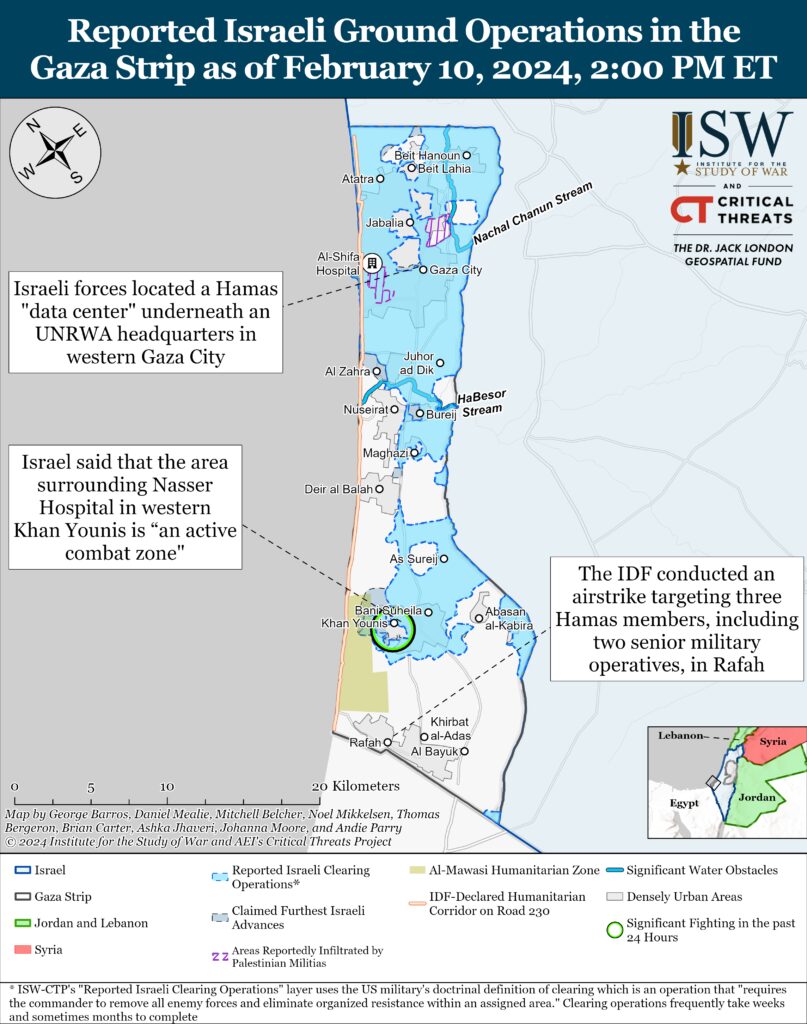
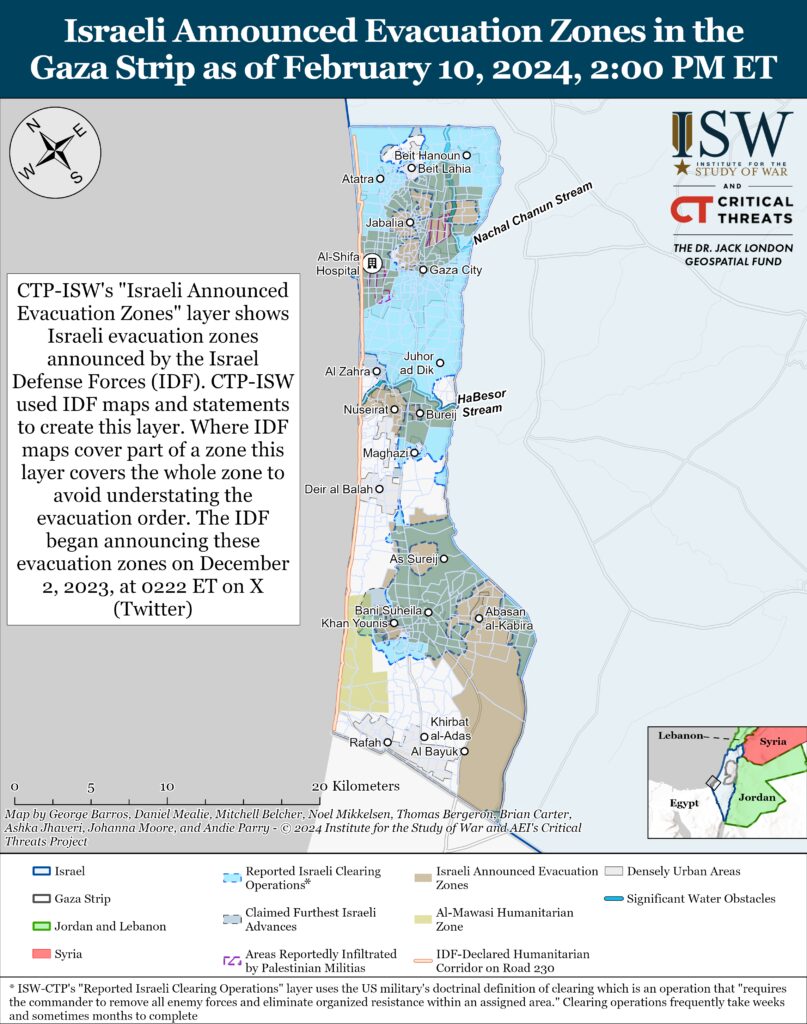
Israeli Prime Minister Benjamin Netanyahu ordered the IDF to complete clearing operations in Rafah before Ramadan begins on March 10, according to an unidentified Israeli source.[xx]
Unidentified Egyptian officials warned that Egypt would suspend the 1979 Egypt-Israel peace treaty if Israel conducted a ground operation into Rafah.[xxi] The 1979 Egypt-Israel peace treaty limits the Egyptian military presence in the Sinai Peninsula.[xxii] Egypt has deployed approximately 40 tanks and infantry fighting vehicles to the Rafah border crossing and added additional fortifications to the border over the past two weeks in anticipation of a potential wave of refugees from Rafah.[xxiii] Israel approved previous Egyptian requests to surge forces into the Sinai for counterterrorism operations[xxiv]
Central Intelligence Agency Director Bill Burns will travel to Cairo on February 13 to discuss resuming hostage release negotiations with Egyptian officials, according to unidentified US and Israeli officials.[xxv]
West Bank
Axis of Resistance campaign objectives:
Draw IDF assets and resources toward the West Bank and fix them thereIsraeli forces clashed with Palestinian fighters four times across the West Bank on February 10.[xxvi]
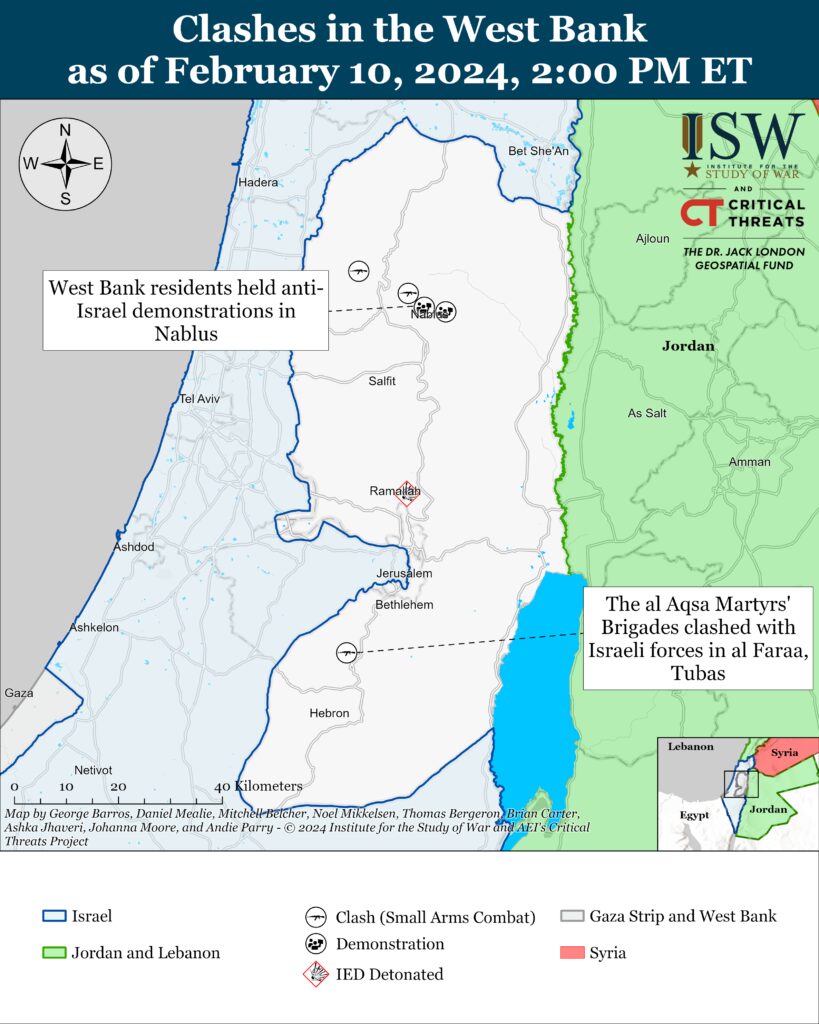
This map is not an exhaustive depiction of clashes and demonstrations in the West Bank.
Southern Lebanon and Golan Heights
Axis of Resistance campaign objectives:
Draw IDF assets and resources toward northern Israel and fix them there
Set conditions for successive campaigns into northern IsraelIranian-backed militias, including Lebanese Hezbollah, conducted six attacks from southern Lebanon into northern Israel on February 10.[xxvii]
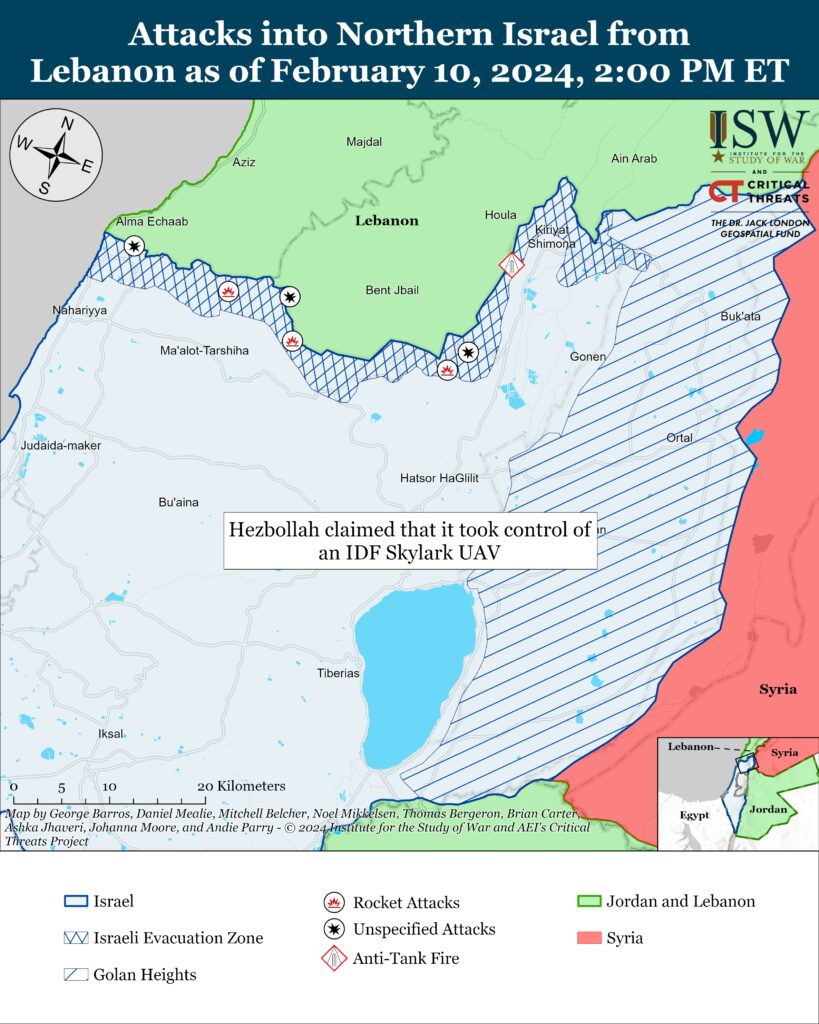
Recorded reports of attacks; CTP-ISW cannot independently verify impact.
Iran and Axis of Resistance
Axis of Resistance campaign objectives:
Demonstrate the capability and willingness of Iran and the Axis of Resistance to escalate against the United States and Israel on multiple fronts
Set conditions to fight a regional war on multiple frontsThe Islamic Resistance in Iraq—a coalition of Iranian-backed Iraq militias—claimed that the United States violated “the rules of engagement” when it killed senior Kataib Hezbollah member Wissam Mohammed Saber al Saedi (Abu Baqr al Saedi).[xxviii] The Islamic Resistance in Iraq called on its supporters to take up arms against the United States and join an Iranian-backed militia. Iraqi Prime Minister Mohammed Shia al Sudani previously claimed that the Iranian-backed Iraqi militias agreed to pause attacks targeting US forces in exchange for a pause in US strikes.[xxix]
The Islamic Resistance in Iraq claimed an attack on an unspecified “vital” target near the Dead Sea on February 10.[xxx]
US Central Command (CENTCOM) forces conducted preemptive, self-defense strikes targeting Houthi unmanned surface vessels (USV) and missiles on February 9.[xxxi] CENTCOM forces struck two USVs, four anti-ship cruise missiles, and one land attack cruise missile in Houthi-controlled territory in Yemen. CENTCOM conducted the preemptive, self-defense strikes after determining that the USVs and missiles presented an “imminent threat” to merchant vessels and US Navy ships in the Red Sea.
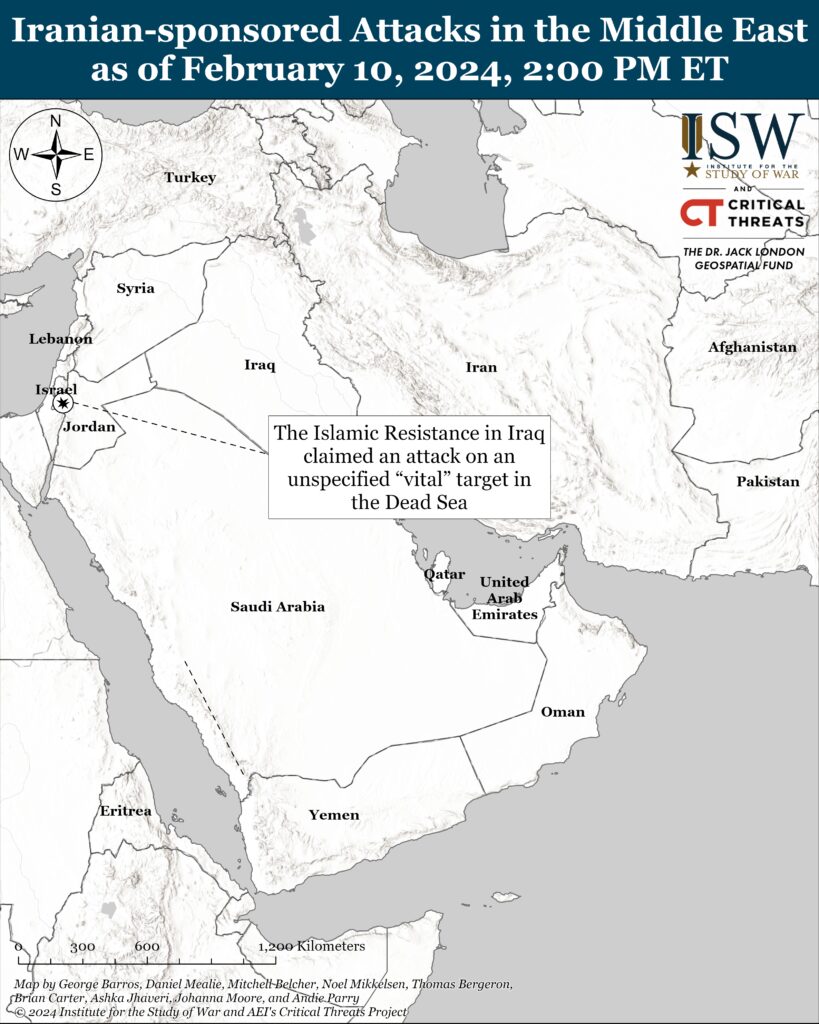
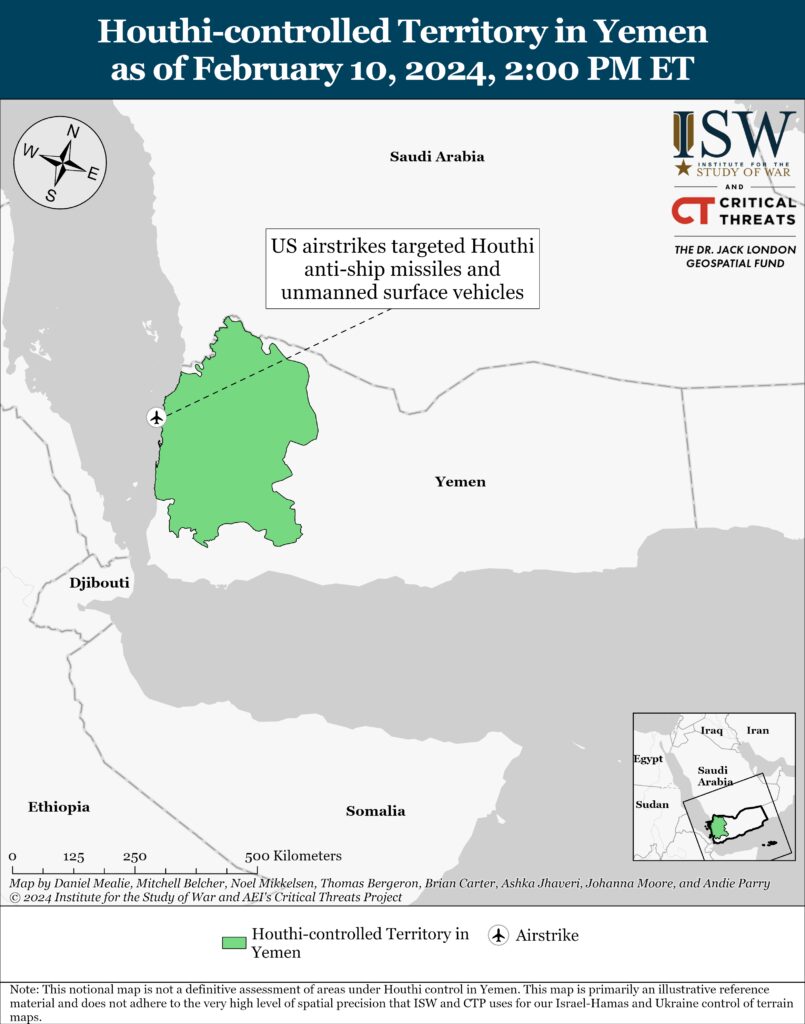
 Eurasia Press & News
Eurasia Press & News

